- Getting around Lijiang. Dont stay in the Old Towns more than 2 days, there is nothing to do. KRISS Oct 9, 2013 05:46
- 2013 Beijing Temple Fair BENNYLAU Feb 26, 2013 03:29
- Malaysian traveling from KUL - LAX vis Shanghai PVG ZATI_DY Jan 3, 2013 20:15
In Darkness and Daylight: Two Sides of Bijiashan
- Views: 4336
- |Vote: 0 0
- |Add to Favorites
- |Recommend to Friends
Travelling Slow to Jinzhou
The slow train to Jinzhou [锦州] grumbled into a packed Benxi [本溪] station. Safe in the knowledge of our hard seat tickets we hung back beyond the 2-elbowed full-speed-ahead attack that constitutes getting on a train in China and boarded last but with unhurried civility.
It turns out the train must have picked up on this and decided to continue the theme of unhurriedness, the expected 4 hours were to stretch … along with the endless green-fielded Liaoning Province… into a much longer journey.
Trains in China are a phenomenon. I love train travel. Each carriage is a microcosm of life and our slow train certainly gave me chance to absorb it. Another day in the 30s found the rows of small green electric fans along the ceiling working overtime and to no real effect. Respite from the heat comes from the breeze that rushes through the open windows, rustling plastic bags and knocking over empty bottles with its force. Occasionally another train passes with a terrifying thwack of pressure that rattles the glass and causes the heart to race a little faster.
I munch on steamed bread and bananas. My fellow passengers are eating sunflower seeds with that familiar rhythmic snapping of shells.
The train has stopped for an uncommonly long time at a small station. It turns out there is only one line and we must wait for another train that is currently on it before we can take our turn. There’s only small farms here, low, squat buildings made from pale muddy bricks. In every spare centimetre of ground sweet corn plants are muscling their tough green leaves up to almost shoulder height, not yet hung with their thick yellow loads. An old man is herding a tumbling crowd of ducklings.
[Image: Liaoning countryside from the train...]
Bijiashan: Present & Future
Jinzhou seems a nice enough town, what little we saw of it. The intensity of the light was startling, perhaps because it’s near the ocean, or perhaps because there wasn’t a single cloud. The late afternoon was still humid. I put on my hat.
The last minibus for Bijiashan [笔架山] leaves at 5.30pm. The journey takes over an hour and at every turn I expect to see the ocean, but we’re not as close as I thought. It’s only as we crest the final hill on the wide, empty road that the sea glints into view and it’s just as quickly obscured by huge scaffolding which signals the end of the road. We are the only two left on the bus.
There is a row of cheap, shabby buildings that are restaurants downstairs and hotels upstairs. A dirt track leads off to the right (parallel with the ocean) to nothing and lined with a few more buildings and a small supermarket hung with umbrellas.
We can only see the island from an image on the billboards that hang on the scaffolding: the real thing is hidden behind a huge photograph of itself. The picture shows a small green island at the end of an invitingly pale, sandy causeway that stretches between the parted waves of a deep blue ocean.
The locals soon cluster around us, my hat only disguises my foreignness for so long, and besides that, we’re the only people here. We are told we can walk across or take a boat ride to the island in the morning. Low tide, when the causeway emerges from the sea, is around 10am.
We follow the boss of one of the hotels who offers us an ensuite room for 50RMB. We check it out: it’s small, dirty and with a squat toilet. We decide we don’t need ensuite and ask to see a cheaper room. We end up with a double bed, a TV that doesn’t work, no lock and a small window that opens out onto the corridor. We can’t complain for just 10RMB each.
We take a walk around. 20 minutes down the road is a small resort with a swimming pool penned in by a long semi-circular sea wall. Inland is a solid wall of billboards showing an unrecognisable place of towering hotels. The sun is setting on this vision of the future of Bijiashan, but we can’t see it; it’s behind a scene of construction to rival any I’ve seen in China. The cranes make their tall, intricate shadows against the soft orange glow.
[Image: Photograph of Bijiashan on ticket & billboards...]
Bijiashan at Dusk
The vast salt-water swimming pool stretches like a lake, bordered by ugly brown sand, but there’s a defiant grace about it. The surface flattens to blue milk and only the occasional dark shape of a night-swimming local disturbs it. We walk a while in the churned-up sand passing empty sun loungers, their white plastic gleaming. Somewhere in the distance a thumping dance tune starts up. The light is fading quickly and we decide to walk to the sea wall, I’m eager to see some waves, to see the real ocean.
The evening is ridiculously humid and the almost-full moon is beginning its climb, silvering the dusk. The ocean, almost the same colour as the sky, is a murky blue alive with the rhythm of the waves. There’s that gentle shushing sound of water on stone. It's impossible to resist the cooling ocean and we decide to take a walk out to a small outcrop of black rocks lying still against the curl of the waves.
[Image: Sunloungers & swimming pool at dusk...]
Bijiashan in Darkness
The sea is warm and the water rises up to our knees at the deepest point before receding again and we reach a small outcrop. We sit and watch the moon rise, it’s white path across the ocean ever increasing. Someone onshore lets off fireworks and for a while the air is all sound and stars.
It’s fully dark. We leave behind a few locals, they have white bags and torches. We watch their tiny lights bobbing like stars that have dropped into the sea. They will go on lifting stones and hunting for crabs all night long.
We walk back to our hotel feeling peaceful, there’s just the hint of a breeze stirring the warm air. A few locals are out strolling but otherwise, except for the moon, the world might be deserted.
Anticipating an early start we go to our hotel to sleep: it’s 10.30pm. Sadly it seems all the world might be here: neighbours arguing; someone’s TV on at full volume and an endless slamming of doors. I don’t remember falling asleep, only the disproportionately loud noise of everyone else staying awake.
[Image: Small rocky island at dusk...]
Bijiashan in Daylight
Arriving somewhere in the evening always gives something a little extra to the experience of travelling. Waking up in the morning there’s that sense of discovery of somewhere new still waiting and so we were up at 6.30am to get our first glimpse of Bijiashan Island.
Few people were around and we followed a small group through a gap in the scaffolding to a ticket office. We made our way to a new, clean concrete concourse, obviously part of the reason for the scaffolding, the other part being a huge stone statue of a woman with her arms outstretched towards the island.
The causeway stretches out to the island. It is a pathway of purple, grey rocks that emerges from the murky waters and stretches its sharp stones into the distance. The island looks tiny and not 100m to the right is a crane-studded wharf that runs from the land out into the sea with all the grace of a motorway. The locals complain the wharf prevents the tide from receding properly, leaving the mid-section of the causeway permanently under water.
Negotiating the Causeway
We walked a couple of hundred meters before the sea stopped us. Other sections of the causeway were visible ahead, but it would be sometime before the sea receded enough for us to reach them. A line of motorboats were moored along one side between the causeway and the wharf. Out to sea, I watched as two fishermen in deep up to their chests, trawled for fish. Every so often their triangular nets would rise out from the ocean like a great sail opening into the sky, the contents were funnelled down into a bag and the net was expertly swung back down beneath the waves.
Hawkers gathered their wares in boxes and bundles and waited. We waited. A few small groups of visitors waited. Every 10 minutes or so we all advanced a few more meters along the causeway. After an hour or so we were perhaps a third of the way to the island with what we realised was too long a wait for the causeway to become crossable. Having come this far, I couldn’t imagine not setting foot on the island so we took a boat and 5 minutes later were deposited ashore.
[Image: First view of Bijiashan Island in the daylight...]
Bijiashan Island: On and Off
Apparently, back in the Qing Dynasty a monk decided to make the island his home as he was convinced it had a powerful aura of feng shui. Moreover he was determined to build some temples on the island and they were constructed completely out of stone (joints and hinges too!). The stone was slid across to the island one winter when the waters in the bay froze over.
A couple of temples remain on the island, the hefty stone bricks a testament to the monk’s devotion. Inside the first we found an old woman sleeping on the floor; she managed a toothy grin at us and gestured to the statues of Buddha. The other temple is circular and has 2 levels with tall steps that wind around the outside. Trapped within each floor is a stone carving that stares unseeing out of a gap in the stonework.
The Island, fortunately for us, was barely larger than it looked. A single path winds across it and it’s a steep but pleasant stroll through moments of peaceful foliage and the ubiquitous stalls selling seashell jewellery, incense and dry seahorses.
Returning back down the path less than an hour later we were passed by a tour group complete with loudspeaker-toting leader and bright red baseball caps. The causeway itself was no longer visible beneath tourists, hundreds of them, thronging across the now shallower waters in single file whilst a non-stop convoy of motorboats shipped many more ashore.
The empty shelly beach we’d landed on was a thriving mixture of sellers and those disembarking. We grabbed a ride on a returning boat going against the traffic, the driver said the tide was as low as it would go, yet parts of the causeway remained knee-deep in ocean.
Dropped back on dry land, we fought our way out against the tourist onslaught. The deserted Bijiashan we’d found the night before had disappeared, unrecognisable beneath a mass of people, taxis and air-conditioned coaches and for a moment I understood that phrase the ‘cold light of morning’. But it's nice to have known, last night when darkness fell, that other side to Bijiashan.
[Image: The tourist onslaught...]
Information (July 2006)
If you like islands, causeways, rocks and other alternative seaside curiosities, you’ll like it here.
If you want beautiful beaches and palm trees go to Hainan.
How I got there
From: Benxi to Jinzhou
By: Train 4302
Cost: 24RMB
Time: 4 hours +
From: Jinzhou to Bijiashan
By: Minibus, turn right outside the train station and walk for 200m.
Cost: 6RMB
Time: 1 hour +
Bijiashan Island
Entrance Fee to Causeway & Island: 30RMB per person
Boat Trip (One-way): 10RMB per person
Travelling Notes
Take the Jinzhou to Bijiashan minibus to the last stop, it stops at lots of smaller places in between.
The causeway to Bijiashan Island emerges twice every 24hours, check with locals for the times.
You can try taking a taxi from Jinzhou train station to Bijiashan, we were quoted 50RMB.
Try and take the time to walk over to the Island, a lot more fun than taking the boat (I would have done this but we had a train to catch from Jinzhou and had to get back in a hurry).
[Image: Stretch limo & construction at Bijiashan...]



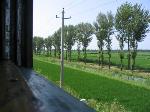
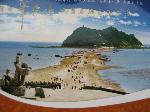
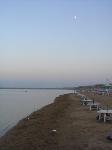
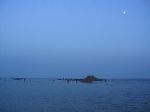
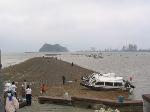
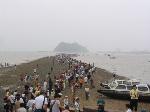
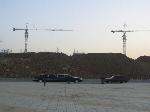
 Copyright © 1998-2025 All rights reserved.
Copyright © 1998-2025 All rights reserved.